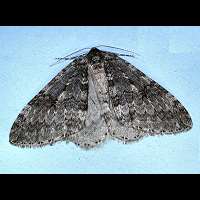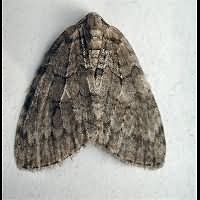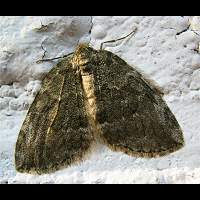November Moth (Epirrita dilutata)
A black and grey geometer which can hardly be told apart from similar species by the naked eye. The November Moth, the Pale November Moth and the Autumnal Moth can only be identified for sure by examining the genitals. To be able to do this, the animals have to be killed and that is something we don't do. Besides: both the November Moth and the Pale November Moth are rather variable. And despite the names, all species appear in October rather than November. Judging by shape, the colour and the third band on the wing, we believe the animals in the pictures to be November Moths, but we are not absolutely sure. The species all have about the same wingspan: 38 to 44 mm.
The eggs are being laid on twigs and branches in October and November, but don't hatch untill April next year. The caterpillar appearing is green on top with a white underside. At the end and the beginning of each segment are reddish brown bands. On the back these sometimes are widened in such a way the caterpillar seems to have a reddish line on the back. The head is green and unmarked. The caterpillar of the November Moth may reach a length of some 26 mm. They are full grown by the end of july and go underground to pupate in a cocoon. The larvae live on a number of trees and shrubs, including oak and birch.
The November Moth flies in just one generation, mainly in October and even earlier in Northern Britain. In mild winters the last animals may be flying about to mid-December. Just like its nephews the November Moth often sits with the wings fully put together on top of the body, a posture usually found in butterflies. May fly at dusk and is regularly seen feeding on Ivy. Comes to light, usually in great numbers. Common in woodlands, parks and gardens. Widespread throughout Britain. On the continent an common species too, even though little is known about the real distribution of the three species because of the difficulties in telling them apart.
A black and grey geometer which can hardly be told apart from similar species by the naked eye. The November Moth, the Pale November Moth and the Autumnal Moth can only be identified for sure by examining the genitals. To be able to do this, the animals have to be killed and that is something we don't do. Besides: both the November Moth and the Pale November Moth are rather variable. And despite the names, all species appear in October rather than November. Judging by shape, the colour and the third band on the wing, we believe the animals in the pictures to be November Moths, but we are not absolutely sure. The species all have about the same wingspan: 38 to 44 mm.
The eggs are being laid on twigs and branches in October and November, but don't hatch untill April next year. The caterpillar appearing is green on top with a white underside. At the end and the beginning of each segment are reddish brown bands. On the back these sometimes are widened in such a way the caterpillar seems to have a reddish line on the back. The head is green and unmarked. The caterpillar of the November Moth may reach a length of some 26 mm. They are full grown by the end of july and go underground to pupate in a cocoon. The larvae live on a number of trees and shrubs, including oak and birch.
The November Moth flies in just one generation, mainly in October and even earlier in Northern Britain. In mild winters the last animals may be flying about to mid-December. Just like its nephews the November Moth often sits with the wings fully put together on top of the body, a posture usually found in butterflies. May fly at dusk and is regularly seen feeding on Ivy. Comes to light, usually in great numbers. Common in woodlands, parks and gardens. Widespread throughout Britain. On the continent an common species too, even though little is known about the real distribution of the three species because of the difficulties in telling them apart.






